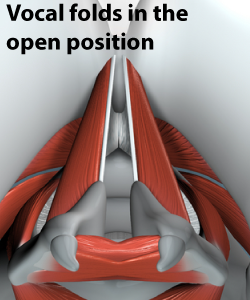COUP DE GLOTTE THE ABUSED ONSET!
 This is the inhale position of the vocal folds. For sound to be made the vocal folds must be brought together.
This is the inhale position of the vocal folds. For sound to be made the vocal folds must be brought together.
Ever since Manuel Garcia talked about the “Coup de Glotte” there have been many arguments about what it means and then questions asked; Can it really ruin the voice? Is it really the beginning of a cough? How can I do the coup de glotte safely? I will answer those questions here.
Let me start by saying that any sound that you make can be done incorrectly and thus have the potential for harming the voice. What stops this from happening? The vocal coach’s ears initially then as he/she imparts that knowledge onto the student, the student then becomes more aware of correct and incorrect singing. This is how a student becomes a great singing. Oh, and of course they need to spend years fine tuning their instrument on vocalises and singing songs too!
Can the Coup de glotte ruin your voice?
The answer is simple if done incorrectly yes! But so can a lip trill.
Why try to learn the Coup de glotte?
The coup de glotte takes some patience and asks for a level of skill that a beginner at singing just doesn’t have so it will take time. You need to already have a good awareness and control over breathing and your vocal folds. Yes to sing you need more than this, but to start with let’s keep it simple. So try it on a hum before you try it on the bright “AH” vowel.
If done correctly the coup de glotte is a great onset that gives a lovely sound to the voice. Not too bright or unfocused, just right (a well balanced, natural sound). If you push or drag up your voice taking the time to learn an onset like the coup de glotte will help you. All you need to learn along with this is how to hold a note, and you will no longer be pushing or dragging up to a note; start with staccato notes first to isolate the correct pitch feeling before you work on holding the note.
Do you start the Coup de glotte with a cough?
No the coup de glotte is not the beginning of a cough. If the coup de glotte were the started with a cough, then Manuel Garcia would have had a very short career as a singing teacher! The light cough that he mentions in his book is simply as an aid to help the student isolate where the sound is come from which is the vocal folds (vocal cords).
I use the vocal fry sound to build a students awareness of the same thing. Not sure if making a vocal fry sound was the cool thing to do back in the old school, but it does draw your attention to the vocal folds beautifully!
How can I do the coup de glotte safely?
To do the coup de glotte safely firstly get a calm but focused mindset. Then after posture and breathing are correct. Focus your attention on the vocal folds. If you are not sure were the vocal folds are then do make a vocal fry sound to isolate them. Once you have this position in your mind bring the vocal folds together as if you were about to do a vocal fry but pause. Note the slight firming of the breath support setting which should be very light and can be felt with one hand over your epigastrium area just below the sternum. Then with your lips already in the hum position and your vocal folds still pinched together start to hum.
If done correctly there will be no jerkiness, pulse or firming in the upper belly. In fact, at the start of the sound, the support should feel the same as the pause. Be patient and don’t expect to get this straight away. It takes time to get this balance of coordination with one on one lessons with me never mind trying to do it by yourself! So it will take a lot more trial and error by yourself. Remember it should never hurt in any way. It will be a little fatiguing to start with so the old rule of little and often is the best way to go.
The Coup de glotte is Safe
So there you go the coup de glotte is safe when like everything in singing it’s done correctly. Remember also to take your time and no jerky breathing.
If you are interested, I have also written about the coordinated onset, aspirated onset and the glottal onset.
If you’re interested in singing lessons with me then you can find out more information on my singing lessons page. I look forward to hearing from you
Hi, I’m Dylan, I’ve been teaching people to sing professionally now for 20 years! I love my job and helping people to sing their very best.
That’s why I created this website (vocaltechnique.co.uk) to help people that want to teach themselves to sing or just want to know more about singing.
It’s been my pleasure to help all levels of singer to reach their singing dreams.
My new singing course “How the Singing Voice Works” is below. Check it out if your interested as I’m giving away a whole section of the course for free in the trial 🙂


